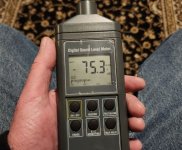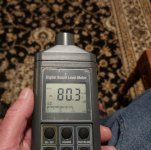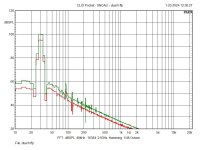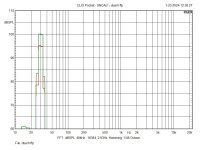3 dB is what one expects when adding two incoherent sources while 6 dB is expected for completely coherent sources. At LFs one wants the LF sources to be incoherent so I guess it's a good thing.I have found on average though, measuring SPL at in room listening position, using full-bandwidth pink, that one sub vs 2, generally adds about +3dB.
The mutual coupling issue is only defined for a free field situation. In a closed room with spaced subs it doesn't work anything like that. Turning one sub on and off will both add and subtract SPL at various frequencies and locations - so much for the mutual coupling concept.
So if you are using a 4 sub set-up to help smooth the response you don't see any increase in sensitivity over the bandwidth?? There has to be some?? If you look at that it's 6db for 1/4 WL and 3db for 1/2 for MC. So for 1/2 same as a non coherent source?
Rob 🙂
Have you ever measured the freq resp of a smarthpone?They are accurate enough for this kind of thing.
I have, and they are not even close.
Some are even equalized plus there is some additional compression etc going on.
So they are most definitely not accurate enough and only work well as relative measurements devices in the speaking range.
(as long as the compression doesn't kick in).
Not to mention the different types of microphones they use, which differs per brand, per model.
As well as the shape of the phone and position.
Even calibrating them for a certain SPL is a tricky business.
Anyway, extremely important point is that there is no knowledge how they perform exactly.
Even much less in a general sense (your mileage may vary A LOT!!)
So we simply can't rely on it.
If your answer is that they are "accurate enough", please show data that shows that this in true for many phones in general.
Even holding a calibrated omni microphone in the wrong way, especially in proximity of things (your body for example) will easily add a couple of dB's.
Last edited:
And for those following along...here's a calculator for summing incoherent sources..http://www.sengpielaudio.com/calculator-leveladding.htm3 dB is what one expects when adding two incoherent sources while 6 dB is expected for completely coherent sources. At LFs one wants the LF sources to be incoherent so I guess it's a good thing.
(With links for coherent summations.)
Youd be surprised, download the app 🫡Oh yes, a phone is gonna be very accurate?
My wife, who is an audiologist, uses here Iphone meter all the time and has compared it to her pro setups with decent results. We are not arguing court cases here and tracing to the NBS is not necessary.If your answer is that they are "accurate enough", please show data that shows that this in true for many phones in general.
I didn't say that there was no increase in sensitivity.So if you are using a 4 sub set-up to help smooth the response you don't see any increase in sensitivity over the bandwidth??
You are still mixing up free field conditions with a closed space. At 1/2 lambda (out -of-phase) in a room, there will be nulls at many places about the room, i.e. -infinity dB gain.There has to be some?? If you look at that it's 6db for 1/4 WL and 3db for 1/2 for MC. So for 1/2 same as a non coherent source?
How do you define what you are asking when the sum of subs in a room is all over the map in frequency and space? Sure 3 dB is a decent rule-of-thumb as an average, but the variations with frequency and location are enormous. What does "sensitivity" even mean in this context.
You are still mixing up free field conditions with a closed space. At 1/2 lambda (out -of-phase) in a room, there will be nulls at many places about the room, i.e. -infinity dB gain.
How do you define what you are asking when the sum of subs in a room is all over the map in frequency and space? Sure 3 dB is a decent rule-of-thumb as an average, but the variations with frequency and location are enormous. What does "sensitivity" even mean in this context.
Hello Earl
Yeah sensitivity wasn't the best choice of words. I also recognize that any speaker placement in a room will have issues at certain frequencies due to placement room geometry and wavelength. That said I just did a sanity check and low and behold I got approximately the same numbers I did when I set up years ago.
I am also making the assumption that the listening and speaker positions have been optimized for the smoothest overall response.
These subs are a mono pair, different locations with EQ and level matching approximately 1/4 wavelength.
This is a 30Hz sinewave meter on slow and A weighting. A solid 5 with some variation both ways. Single and pair.
I understand that as the frequency changes SPL will vary and can't be uniform across the whole bandwidth. That is just like any other speaker pair.
I also agree that bandwidth limited noise would be a better test signal.
Rob 🙂
Attachments
This has absolutely zero to do with "court cases". Kinda dramatic thing to say.My wife, who is an audiologist, uses here Iphone meter all the time and has compared it to her pro setups with decent results. We are not arguing court cases here and tracing to the NBS is not necessary.
But just one anecdotal personal sample is not enough to say that every smartphone is just fine estimating sound pressure levels.
"Decent results" also still doesn't provide any real numbers btw.
Some phones might be reasonable, but like I said before, your milage may vary a lot.
It's just bad engineering and science to just assume these kinds things.
It's just poor practical advice to use as a general statement for people who are unknown to all of this.
I am personally always very careful claiming such statements, because I know that the average reader, reads it as the truth.
I have and tested several phones, I wasn't surprised how high the error was.Youd be surprised, download the app 🫡
Best cases were good, within a dB or so. Worst cases where off by more than 3dB.
Some having quite the error in the frequency response, meaning that in some cases you could over estimate certain things way to much.
There was also quite the discrepancy in how to hold the phone, as well as how dirty, old and dusty the microphone was.
Conclusion still is that your milage may vary an awful lot.
There are way to many variables, incl practical ones, to be able to rely on these devices.
If you wanna have an extremely rough estimate if something isn't 30dB(A) or 100dB(A), sure.
But just can't quantify any numbers to it.
Even with cheap microphones for measuring, there is quite some discrepancy.
There are plenty of articles online that show how bad this is.
It's just bad engineering and science to just assume these kinds things.
The more you know, definitely, I did question the accuracy. I was more worried about scaling but non the less I compared results with my u-mik and found it surprisingly precise. This is some time ago, and what I remember is feeling like, wow.... so the spl meter is precise and the theater really did hit those super loud peaks?
I would definitely consider the quality, I mean this thing lives in my pocket, I do construction, a material, a liquid, leaving its signature on the diaphragm is a possibility.Best cases were good, within a dB or so. Worst cases where off by more than 3dB.
View attachment 1114103 View attachment 1114142 I was going to ask about the Sm80F then I found your remarks on your project....Center to center spacing is definitely better on the Sm80F, but I suspect that, that, wasn't the deal breaker for you?
I would be interested in measuring each section, (speaking on your current Synergy) solo'd, and at peak levels, like 115db/1m(THD). I share your thoughts on max excursion of a driver affecting HF of said driver. I think it is synonymous within the community actually and not trivial. The grey area being, whats perceptible
I agree, based on my readings about the average motor, and personal experience with the woofers I have, it seems to line up. How this works with a compression driver I am not sure....the excursions are so small I don't think BL falls at all, but I have never seen BL curves for a large format compression driver.
So I did some comparison with my U-Mik, vs the Iphone SPL meter app.... Focusing on the matter of peak readings. The app Lcpeak vs rew True ZPeak, It seemed to stay mostly accurate. The phone stayed consistently 2db higher than the microphone, in the loud passages and in the lower passages not sure whats going on lol. I don't think they are using the same formula to derive peak but its seems to be close enough for ball parking what I am trying to analyze.
View attachment 1114665
Im not sure what do with this one, but it happened more than once, kinda strange because I nvr came across such high readings later into the movie....just longer durations with the 128db peaks....climax of the movie likely.
Factor in the 2db difference I had with my u-mik, these numbers are still high. 130db peaks? 126db peaks?
That was then, Now I have a newer iphone, so scientifically I would want to at least re evaluate the situation. I am currently waiting on a cord for my U-Mik.
Rob,This is a 30Hz sinewave meter on slow and A weighting. A solid 5 with some variation both ways. Single and pair.
I understand that as the frequency changes SPL will vary and can't be uniform across the whole bandwidth. That is just like any other speaker pair.
Using "A" weighting, 30Hz reads -40 below actual level.
The reading of 80.3 dBA (slow) could be 30Hz at 120.3dB SPL, 2nd harmonic (60Hz) at ~105dB SPL, 3rd harmonic (90Hz) at ~60dB SPL, or any combination of fundamental and harmonic distortion adding up to 80.3 dBA.
At any rate, we can't tell which frequencies are adding to the +5dB gain in those two different locations from a dB meter.
The reading of 80.3 dBA (slow) could be 30Hz at 120.3dB SPL, 2nd harmonic (60Hz) at ~105dB SPL, 3rd harmonic (90Hz) at ~60dB SPL, or any combination of fundamental and harmonic distortion adding up to 80.3 dBA.
At any rate, we can't tell which frequencies are adding to the +5dB gain in those two different locations from a dB meter.
Thanks hey if you mess up might as well go all the way! I confused A and C will give it a try using C. As soon as my furnace shuts off! Cold here!!
LOL Rob 🙂
Last edited:
Hello weltersys
Thought about the balance of your post about harmonics and did an FFT comparison using Clio Pocket. Just loaded the new 3,0 software so I had to give it a spin. Getting the same 5 Db and looks clean to me WRT harmonics not being an issue.
Rob 🙂
Thought about the balance of your post about harmonics and did an FFT comparison using Clio Pocket. Just loaded the new 3,0 software so I had to give it a spin. Getting the same 5 Db and looks clean to me WRT harmonics not being an issue.
Rob 🙂
Attachments
Yes, the third harmonic at -41dB below the fundamental (about 1% HD) is no issue (how about at 120dB..), and the gain of 5dB at that location and frequency when doubling cabinets is near the ideal of 6dB.
Other frequencies probably won't be so close to the ideal 😉
Other frequencies probably won't be so close to the ideal 😉
About 10 years ago an old Holden hearse was sold here. The ad stated that this catafalque was used to deliver bread from a bakery😎.Just get a Holden
For some reasons I didn't buy this vehicle.
Last edited:
Time to dampen the slot...
I've got 120"x120" of cotton batting. I understand that density plays a roll in the efficacy of the sound absorption . The batting in multiple layers should get the job done don't you think? Less mess than rockwool, less messy than poly/cotton/wool fill, supposedly more effective than polyester batting due to tighter structure.
I've got 120"x120" of cotton batting. I understand that density plays a roll in the efficacy of the sound absorption . The batting in multiple layers should get the job done don't you think? Less mess than rockwool, less messy than poly/cotton/wool fill, supposedly more effective than polyester batting due to tighter structure.
Density plays a role, but thickness is usually the dominate factor. To work at LFs it has to be thick.
- Home
- Loudspeakers
- Multi-Way
- Is it possible to cover the whole spectrum, high SPL, low distortion with a 2-way?



